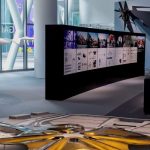The world of art is constantly evolving, responding to the dynamic events that occur in society and culture. From classical Greek sculptures to modern street graffiti, these artistic expressions have served as a reflecting surface for our collective consciousness. Moreover, as technology has changed, so has the way artists create their works – no longer tied down by physical or geographical boundaries, we are experiencing a new kind of interconnectedness between different cultures across the globe.
Changing trends in world art
In recent years, the prevalence of digital media has caused a proliferation of mixed-media artwork being created and shared online. In addition, digital collage art has become increasingly popular using images from magazines and photographs pulled from the internet. This accessibility to new materials and tools enables artists to explore more abstract ideas in their work and create entirely new works that express their unique perspectives.

In another trend, more traditional art forms have been adapted to create a new expression. For example, mural painting has become increasingly popular as an effective medium for public art that can be used to make political statements or express beauty in the physical world. Similarly, street artists use techniques such as stenciling or spray-painting to share their ideas with a wider audience.
Finally, the emergence of virtual reality and augmented reality art is beginning to revolutionize how we experience the artwork. By virtually interacting with an artwork, viewers will be able to explore its environment and meaning in previously impossible ways. As technology continues to develop, so will the way we experience art.
Environmentalism
The concept of environmentalism has become increasingly prevalent in the art world, with artists using their work to draw attention to issues such as climate change and endangered species. Artwork of this genre often utilizes materials from nature or even directly incorporates natural elements into the artwork. In addition, some artists are exploring more abstract concepts related to the environment, such as the pollution of oceans or air quality. As the world continues to confront environmental issues, art will continue to be a powerful tool for expressing our collective concern and inspiring action.
Political artwork
Political artwork has long been used to express ideas on topics such as civil rights, feminism, and other forms of activism. In recent years, the power of social media has enabled artists to spread their message more quickly and efficiently than ever before. As a result, contemporary political artwork often uses irony or satire to make its point, allowing viewers to understand complex issues in an accessible way.
Digital art

Finally, the rise of digital art has opened up a new avenue for creative expression. Digital art can take many forms, from CGI animation and video game design to generative artwork that responds to its environment. By utilizing cutting-edge technology, artists can create interactive experiences allowing viewers to become part of the work. As technology continues to improve and more people become comfortable with digital platforms, this art form is likely to become increasingly prevalent in the coming years.
Conclusion
The development of modern art continues to be shaped by the ever-changing landscape of society and technology. By utilizing the latest tools and materials, artists can create works that reflect the issues and trends of our times. As this trend continues, we can expect to see more unique forms of expression emerge as art evolves in the digital age.












